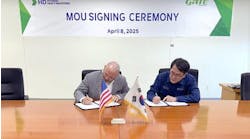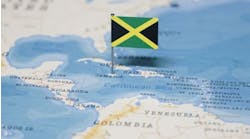Drilling association supports a wider role for coiled tubing
Drill string failures and costly subsea workovers are high on the list of problems preoccupying Europe's Drilling Engineering Association. The DEA(E), which is supported by 54 oil companies as well as drilling service contractors and academic institutes, has helped kick-start over 30 research projects since 1988.
These projects, which have attracted funding totaling more than $15 million, have led to the development of numerous technologies aiding drilling efficiency. Unlike the SPE, DEA(E) is an organization which identifies its members' technology needs, in turn helping to form relevant joint industry R&D schemes which are paid for by the members: DEA(E) does not have funds of its own to sponsor or manage research.
The Association is chaired currently by Alan Hippman of Amoco (UK), with British Gas E&P's drilling engineering manager Hussain Rabia acting as secretary. Ideas for research projects - not limited purely to companies from Europe - can be presented at one of DEA's quarterly meetings.
Members also give longer technical presentations of their own relevant to the theme of the meeting. At last month's session in Vienna, sponsored by OMV, the topic was Reeled Tubing & Slimhole. The final 1996 session, to be held in London in December, will focus on Management Systems, as well as setting the agenda for next year's special themes: subjects last year included High Pressure/High Temperature (Dusseldorf) and Multilaterals/Horizontal Drilling (London).
By the end of each meeting, problem areas are identified and listed as needing remedial action. The June 1996 meeting in Bergen, focusing on Deepwater Technology, generated a lengthy line-up of general knowledge gaps which included:
- deepwater wells - planning: hazardous operations studies, in situ gas hydrate prediction, and downhole safety valves
- operational issues: potential use of casing as a riser, cementing at low temperatures and well testing in DP operations
- risers: hang-off/disconnect procedures, and interaction between the drill string and risers
- BOPs/wellhead/trees: casing shear ram capability, connector failure and BOP sensor needs
- information transmission: alternatives to hardwire transmission (i.e. acoustic) for subsea to surface communications.
Ideas procedure
Ideas for new projects are vetted by Hussain Rabia before making it to the presentation sessions. At the end of each meeting, DEA(E) asks its oil company members to grade their interest in the ideas as high, medium or low. Those with the most highs and mediums go forward.
Even then, however, some ideas will remain grounded or may take a couple of years to gain sufficient support. Projects are often phased over one to two years, with multiple sponsors sought to bring down the shared costs.
Each project is allocated a number, allowing DEA(E) to track whether it proved to be successful or not. Progress is updated in quarterly reports to members. Some idea merchants such as Rogaland Research in Stavanger are keen self-promoters at DEA fora. "But we also encourage the one-man band," says Rabia. "The common thread is that the idea is good - even if it looks to be pie-in-the-sky."
Among the more successful ideas at present is DEA 68, a joint industry program between four oil companies, a service contractor and GEC Marconi in the UK. Their aim is to develop a system for high resolution prediction of formation boundaries and rock properties ahead of the drill bit. Sub-goals include increased drilling efficiency and rate of penetration through prediction of over-pressure regions ahead of the drill bit; and accurate casing point identification and drill bit change.
Following a feasibility study completed this February, design and construction is under way of an acoustic Look Ahead of the Bit system with resolution of better than a meter. This will be integrated into a borehole assembly for use with an 8 1/2-in. PDC drill bit, to be tested on boreholes belonging to the sponsoring members. The system should be able to detect acoustic boundaries tens of meters ahead of the bottom of the borehole while drilling, without the need for tripping.
Under another DEA(E) project, British Gas is sponsoring Intera to compile a drill string failure database: resultant statistics would highlight patterns and trends that might assist investigations into causes of failures. Five participants are being sought to fund the $350,000 costs over two years, but as Rabia points out, identifying hazards that would allow one drill string failure to be avoided would in turn save the participating oil company close to $1 million.
Intera would incorporate failure data from participating companies with data from British Gas' own research over the past five years into drillstring vibration. British Gas has developed a software tool that allows a drilling engineer to select a BHA configuration and predict operating conditions that would cause harmful vibration (such as high cyclic stress).
Data for the tool came from tests on a 25 ft rig erected to house scaled model drill strings, and from surface and downhole vibration measurements made in wells drilled in the North Sea. The collected data is used to develop and validate the mathematical models in the software. Algorithms from these models have been coded into a PC program for Windows that can predict critical rotating drilling speeds for sections of hole. The models are now being refined to also investigate jarring.
Another joint industry project, presented to the DEA(E) throng in Bergen in June, concerns a cost-effective technique for subsea well intervention. Accessing subsea wells prior to commencement of drilling is so costly that some operators have been forced either to delay workovers or avoid using equipment such as electric submersible pumps which are notorious for needing frequent servicing and replacement.
The aim of this project, managed by XL Technology in the UK, is to produce a coiled tubing reeled flexible riser that would cut costs in the following ways:
- No heave compensation equipment would be required during any part of the operation; this would allow a larger tolerance for station keeping for the vessel throughout the time it stays connected to the wellhead.
- The riser would be designed to provide improved safety and environmental protection, at the same time housing all umbilicals for subsea, BOP, ROV, actuator and buoy operations. During riser deployment, all umbilical systems would be active: the riser's profile would be monitored and controlled through use of smart buoys.
- Riser diameter would be optimized for surface handling equipment - for instance, a 5 1/2-in. diameter ESP assembly could be deployed with a 3 1/2-in. diameter riser. All operations would be performed by ROVs.
Coiled tubing has not been used before as a riser for subsea intervention, but it would prove more cost-effective, according to XL Technology, than either a jointed rigid riser or a flexible braided armor hose. The reeled riser would also impact favorably vessel specification and hence day rates. No anchors have to be deployed with this system, meaning that the reeled riser and installed intervention coiled tubing are ready for operation when the vessel arrives on location. Operations will therefore be quicker, so overall costs will be reduced.
Buoys have been used with production risers before, but never as a `smart' element of the process - in this case, supporting guidelines for the riser/wellhead alignment.
XLT is discussing provision of this service internationally with several underwater service contractors. Cost of the development is put at $345,000. A subsequent aim would be to investigate adapting the technology for use as a slimhole drilling system.
XLT is also involved in DEA(E)'s other showcase joint industry project, sponsored by Agip, BP, Elf, Enterprise Oil, Shell and Texaco. This is examining the technical and commercial potential for an electric motor to drill a hole using coiled tubing. The feasibility study, completed this year, came up with the following conclusions:
- Electric motors are available with up to eight times the horsepower/specific column of positive displacement motors.
- These could be adapted for operations in temperatures above 400°F.
- Lower pump rates, required for hole cleaning only, would result in reduced pumping pressure and reduced fatigue-induced damage to coiled tubing.
DEA in Europe is separate from its counterpart in the US. As no such organization exists in the Middle or Far East, some Japanese oil companies have affiliated themselves to the European version. "We would also like companies from Greece, Turkey, Tunisia and Egypt to participate," says Rabia.
For more information, contact Hussain Rabia, British Gas. Tel: (44) 1734 353222 or fax (44) 1734 292940.
Copyright 1996 Offshore. All Rights Reserved.


